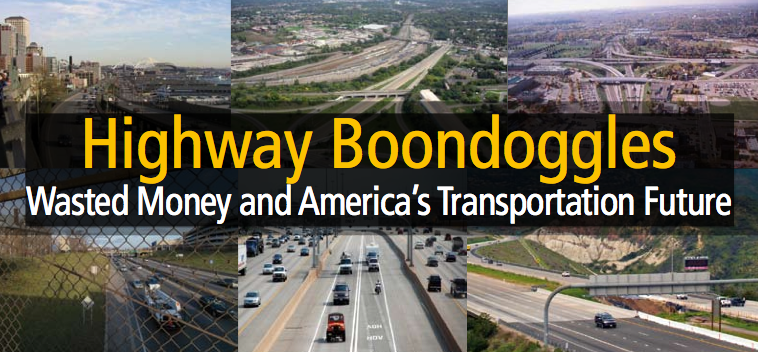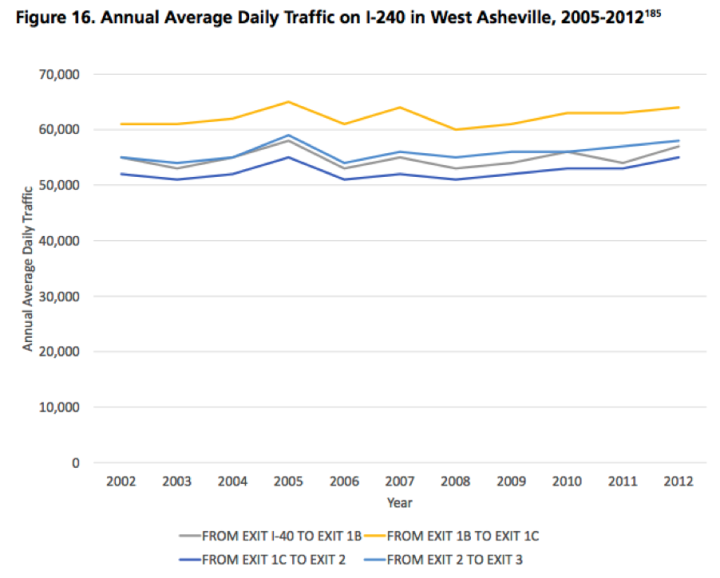A new report by a national liberal advocacy group takes aim at the proposed local Interstate 26 connector project, calling it one of the top “highway boondoggles” in the country.
The plan to construct a new section of interstate near downtown Asheville and remake the section of Interstate 240 leading to West Asheville has long been a subject of contentious debate, as community leaders, elected officials, state transportation staff and experts have argued about routes, costs and the project size.
Funded by the U.S. PIRG, a national federation of state Public Interest Research Groups, the new report highlights the Asheville project as an example of a $400 to $600 million taxpayer expenditure with questionable benefits. Some proposals for the connector call for widening about 4.3 miles of I-240 from four to eight lanes. But since 2004, traffic “has not increased significantly along that stretch of road,” according to the report, titled “Highway Boondoggles: Wasted Money and America’s Transportation Future.”
“The cost of going to eight, rather than six, lanes appears to be unjustified by the reduction in congestion that would result,” the report concludes. “The time saved by adding the two extra lanes would be just 9.6 seconds per driver (out of a 6.5 minute travel time) during the morning rush hour and 17.4 seconds during the evening.”
The report was released Sept. 18, just one day after Gov. Pat McCrory announced a broad “25-year Vision” for state transportation improvements. In Western North Carolina, the plan emphasizes upgrading U.S. Highway 74 to interstate standards from Asheville to Charlotte and onward to Wilmington. It also calls for generally “improving interstate connections” but doesn’t specifically include funding for the I-26 connector.
However, contrary to McCrory’s emphasis on interstate construction, the U.S. PIRG report declares that the country’s “driving boom is now over.” Instead of investing “vast sums of money into the construction of new highways and expansion of old ones,” state and federal governments should focus on repairing existing roads and bridges as well as public transportation improvements.
The total number of miles Americans drive is lower than it was in 2005, while per-capita driving has fallen by 7 percent in the last nine years, according to the report. Fueling the trend is a movement towards living in central city districts rather than the suburbs. Changing attitudes towards driving are being influenced by high gas prices as well as a Millennial generation that is increasingly interested in multimodal alternatives, according to the report.
Meanwhile, supporters have argued for decades that the I-26 connector project is needed to improve safety and grow commerce. Lead by an ad-hoc group of local officials and community leaders, both the Buncombe County Board of Commissioners and Asheville City Council passed resolutions this spring urging the North Carolina Department of Transportation to make funding the project a top priority.
In addition to the local project, the national U.S. PIRG report highlights 10 other highway projects across the country – slated to cost $13 billion – that “exemplify the need for a fresh approach to transportation spending.”





Check out this graphic by Joe Minicozzi. I’m assuming he’s using the same numbers, but Joe has gone further back, and also added the various NCDOT projections that supposedly justify 8 lanes. Boondoggle doesn’t even begin to cover this:
https://dl.dropboxusercontent.com/u/108366839/I-240%20Projection%20Analysis%209-15-14.pdf
And how much will these extra two lanes add to the cost, and how empty are those NCDOT coffers, and how big are those checks from the private companies wanting to jam P3 toll lanes onto I-26 like they’re doing to I-77? These are the questions I wish some local media types would ask so I can go back to my day job…